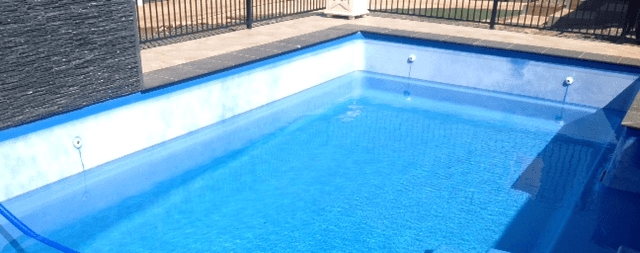
Calcium Hardness in Fiberglass Pools
Calcium hardness (CH) refers to the amount of calcium mineral in your pool water. When CH is above 275ppm we refer to the water as being 'hard.' When the water is below 175 we refer to it as being 'soft.' If you have ever lived with well water you may be familiar with high or low levels of 'hardness.' And what that feels like.
Pool stores such as Leslie's Pool Supplies regularly test owners water and gives them a report of what they need to BUY... I mean 'add' to their pool to solve a problem. The real PROBLEM here is that there are different types of pools (concrete, vinyl, fiberglass), requiring different types of management approaches, located in different states / climates, experiencing different seasonal changes, and used by families with very different bather patterns. Despite all of these variables, the pool store is going to test the water, then (assuming the test is right) recommend adjustments based on ONE set of ranges for every pool. That doesn't work.
What is the right calcium hardness in your pool? That depends. Calcium hardness levels are extremely important in plaster or concrete pools. They should be kept between 200ppm-400ppm. All concrete / plaster material has CH in them. If the water doesn't have enough CH, the water will seek and remove the CH from the plaster to satisfy its 'need' for CH. We call this etching and it will leave the concrete or plaster pitted and damaged which of course is not good.
When it comes to fiberglass pools we are not that worried about CH when it is low. Different manufactures have different recommended ranges in their manuals. To be completely transparent it doesn't seem as though they have put any thought or research in those recommendations. Instead, they have adopted those ranges because they are the 'default' or 'we have always done it this way' range.
We have Luxury Pools that we have managed for years with CH anywhere from 0-75 with no issues. We would choose for it to be low over high and we nearly NEVER want to add CH. When the CH is on the higher side, coupled with other factors, that is when problems can occur. If the waters pH is not kept balanced and in proper range, and / OR is kept at a higher temperature, the calcium can fall out of the water and stick the pool and equipment. This can cause surface discoloration as the white calcium scale sticks to everything in the pool and makes everything look white.
Going to the pool store to have your water tested is a good way to cross check your own test results. We highly recommend using our chemical calculator and dose your pool as it guides you. Kindly thank the Leslie's team member for their help, buy what you may need, and follow the Luxury Pools and Living Calculator.
When SHOULD you add CH to your pool water? When is it important to target a 200-400ppm range? When your pool structure has CH in it. We mentioned above that concrete pools and finishes have CH, and if your water doesn't have CH, the water will steal it. This same phenomenon can happen with vinyl liners and CHEAP fiberglass. There IS CH in vinyl liners and some fiberglass gelcoat. It is used as a cheap filler in the manufacturing process. If the water does not have enough CH on its own, it will steal that CH as well. This makes vinyl liner brittle and hard and makes cheap gel coat feel rougher. Your Luxury Pool does not fall in this category as our pool have NO CALCIUM fillers. So... Luxury Pool Owners... keep your CH low. You don't need it and it only brings risk to your pool water.
Pool Article Categories:
Copyright Luxury Pools and Living 2005-2026
Cookie Policy | Privacy Policy